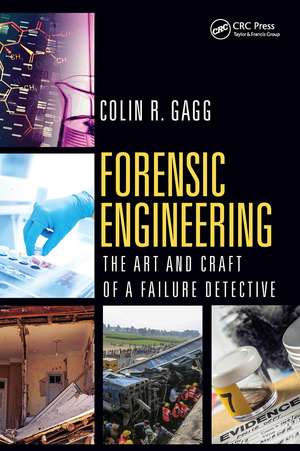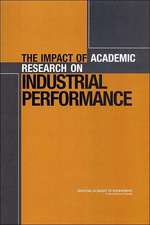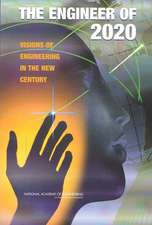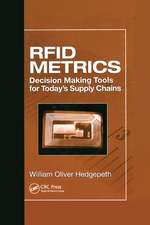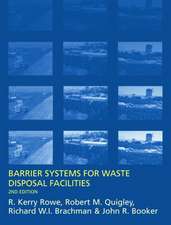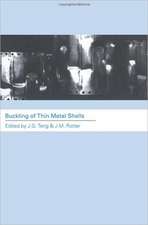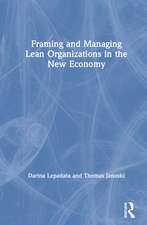Forensic Engineering: The Art and Craft of A Failure Detective
Autor Colin R. Gaggen Limba Engleză Hardback – 6 mar 2020
The techniques covered in the book are applied to the myriad types of cases the forensic engineer and investigator may face, serving as a working manual for practitioners. Analytical techniques and practical, applied engineering principles are illustrated in such cases as patent and intellectual property disputes, building and product failures, faulty design, air and rail disasters, automobile recalls, and civil and criminal cases. Both private and criminal cases are covered as well as the legal obligation, requirements, and responsibilities under the law, particularly in cases of serious injury or even death.
Forensic Engineering will appeal to professionals working in failure analysis, loss adjustment, occupational health and safety as well as professionals working in a legal capacity in cases of produce failure and liability—including criminal cases, fraud investigation, and private consultants in engineering and forensic engineering.
Preț: 483.01 lei
Preț vechi: 618.00 lei
-22% Nou
Puncte Express: 725
Preț estimativ în valută:
92.44€ • 96.25$ • 78.12£
92.44€ • 96.25$ • 78.12£
Carte tipărită la comandă
Livrare economică 07-21 martie
Preluare comenzi: 021 569.72.76
Specificații
ISBN-13: 9780367251680
ISBN-10: 036725168X
Pagini: 420
Ilustrații: 810
Dimensiuni: 156 x 234 x 25 mm
Greutate: 0.94 kg
Ediția:1
Editura: Taylor & Francis
Colecția CRC Press
Locul publicării:Oxford, United Kingdom
ISBN-10: 036725168X
Pagini: 420
Ilustrații: 810
Dimensiuni: 156 x 234 x 25 mm
Greutate: 0.94 kg
Ediția:1
Editura: Taylor & Francis
Colecția CRC Press
Locul publicării:Oxford, United Kingdom
Public țintă
Professional and Professional Practice & DevelopmentCuprins
I Preface
II Contents
III Acknowledgements
Chapter 1
Failure analysis or forensic engineering?
1.0 Synopsis
1.1 Historic failure analysis
1.2 Conventional failure analysis
1.3 Product defects
1.4 Causal Analysis
1.4.1 Computer aided causal analysis
1.4.2 Case Study: wear markings as ‘fingerprints’
1.5 Design calculations and modelling
1.5.1 Miner’s Law for life time cumulative damage prediction
1.6 Summation of conventional failure analysis
1.7 Forensic engineering
1.7.1 Case Study: Collapse of the Rana Plaza factory
1.8 Range of competence
1.8.1 A generic failure analysis or a forensic investigation?
1.9 Forensic approach to failure
1.9.1 Reverse engineering
1.9.2 Associated costs of forensic investigation
1.10 Historic failures
1.10.1 Computer-aided technology limitations
1.11 Analytical techniques
1.12 Dissemination of knowledge and experience
1.12.1 Popular books
1.12.2 Event reporting
1.12.3 Text books
1.12.4 Forensic engineering teaching
1.13 Case study themes
1.13.1 The Sayano-Shushenskaya power station accident of 2009
1.14 Research enriched teaching
1.15 Concluding remarks
1.16 References
Chapter 2
Initial aspects of forensic failure investigation
2.1.1 Assessing the situation
2.1.2 Initial visual observation as a fact-finding exercise
2.1.3 The failure scenario
2.1.4 Summary of understated investigative skills
2.2 Visual observation
2.2.1 Case study: visual comparison
2.2.2 Case study: common (engineering) sense
2.3 Forensic photography
2.4 Record keeping
2.5 Witness evidence
2.6 Documentary evidence
2.6.1 Case study: Fatal aircraft crash
2.7 Product and material standards
2.7.1 Case study: Step ladder accident
2.8 Patents
2.9 Surviving remains (detritus)
2.9.1 Gathering of evidence and the ‘Chain of Evidence’
2.10 Product liability
2.10.1 Case study: Premature failure of a presentation cake knife
2.11 The ‘Corporate’ environment
2.11.1 Case study: Bird-strike testing of aircraft engines
2.12 Abuse or misuse
2.12.1 Case study: abuse
2.12.2 Case study: miss-use
2.13 References
Chapter 3
A framework or methodology for forensic investigation
3.2 An investigative path followed by the writer
3.2.1 Intuition (reasoning) and a ‘structured’ investigation framework
3.2.2 Individual stages of investigation
3.2.3 The field investigation kit
3.2.4 Initial approach to failure investigation
3.2.5 Background data collection
3.2.6 Sifting the evidence
3.2.6.1 Case study: Failure of a new design of horse bit
3.2.7 Records
3.2.8 Single items of evidence
3.3 The failure detective
3.3.1 Transformation stresses
3.3.2 Establishing a load transfer path to determine the ‘weakest link’
3.3.3 Case study: The weakest link principle
3.3.4 Case study: Failure of a backhoe dipper arm
3.4 Computer-aided technologies
3.4.1 Case study: failure of an open-ended spanner
3.5 The forensic engineering Report
3.6 Concluding remarks
3.7 References
Chapter 4
Analytical methods
4.0 Introduction to a typical forensic engineering ‘toolbox’
4.1 Non-destructive testing (NDT)
4.1.1 Case study: Failure of a power transmission shaft
4.2 Crack detection and the human eye
4.2.2 Surface appearance of common cracks
4.2.3 Other crack detection techniques
4.3 Hardness testing
4.3.1 Case study: Pin-punch splintering
4.3.2 Relationship between hardness and tensile strength
4.4 Indirect stress/strain analysis
4.4.1 Brittle lacquer technique
4.4.2 Case study: Cycle accident
4.4.3 Photo-elastic stress measurement
4.5 Conventional (contact) radiography
4.5.1 Case study: Failure of a vehicle motherboard
4.5.2 Case study: Heavy goods vehicle fire
4.6 Summary of NDT inspection
4.7 Forensic optical microscopy
4.7.1 Macroscopic examination
4.7.2 Examination under magnification: optical microscopy
4.7.3 Reflected light microscopy
4.7.4 Stereo microscopy
4.8 Metallography
4.9 Scanning electron microscopy
4.9.1 The environmental scanning electron microscope (ESEM)
4.9.2 Case study: Hit and run accident
4.10 Optical versus scanning microscopy
4.10.1 Case study: Printed circuit board (PCB) failure
4.10.2 Case study: Prototype PCB failure
4.11 Energy dispersive X-Ray analysis (EDAX)
4.12 Destructive testing methods
4.12.1 Tensile testing
4.12.2 Flexure or bending
4.12.3 Case study: Cracking of aluminium pressings
4.12.4 Torsion testing
4.12.5 Shear testing
4.12.6 Izod or Charpy impact test
4.12.7 Differential scanning calorimetry (DSC)
4.12.8 Case study: Electronic component registration difficulties
4.13 Novel tools and techniques
4.13.1 The contour method
4.13.2 Neutron diffraction
4.13.3 Nano test systems
4.13.4 Flash thermography
4.13.5 Thermographic Signal Reconstruction (TSR)
4.13.6 Electromagnetically induced acoustic emission (EMIAE)
4.13.7 Pulsed eddy current (PEC)
4.13.8 Microwave technology
4.14 References
Chapter 5
Sources of stress and service failure mechanisms
5.0 Introduction
5.1 Fundamental mechanical background
5.1.1 Stresses and strains
5.1.2 Ductile and brittle transition
5.1.3 Fracture toughness and linear elastic fracture mechanics (LEFM)
5.1.4 Limitations of a fracture mechanics approach
5.1.5 Stress Concentration (Kt)
5.1.6 Case study: stress concentration – cement mill power input shaft
5.1.7 Residual stresses
5.1.8 Summary of fundamental mechanical background
5.2 Service failure mechanism
5.2.1 Case study: Hubble space telescope mirror and the Team Philips catamaran
5.3 Mechanical Failure
5.4 Hydrogen Embrittlement
5.4.1 Sources of hydrogen
5.4.2 Hydrogen induced brittle failure
5.5 Impact
5.6 Bending
5.7 Torsion
5.8 Creep
5.9 Fatigue
5.9.1 Minimizing susceptibility to onset of fatigue failure
5.9.2 Case study: Failure of a power transmission gear wheel
5.9.3 Fatigue related failure modes
5.9.4 Approximating the history of a fatigue failure
5.9.5 Summation of fatigue as a service failure mechanism
5.10 Wear
5.11 Corrosion
5.11.1 Case study: The Statue of Liberty
5.11.2 Stress Corrosion Cracking (SCC)
5.11.3 Case study: SCC of brass impeller blades
5.12 Manufacturing fabrication as a source of stress
5.12.1 Casting
5.12.2 Casting Failure Analysis
5.12.3 Case study: Extrusion press
5.12.4 Welding
5.12.5 Quench cracking
5.12.6 Tempering and toughening
5.13 References
Chapter 6
Fracture morphology and topography
6.0 Introduction
6.1 What is meant by the term ‘failure’?
6.2 Fracture and fracture path morphology
6.3 Ductile or brittle failure
6.4 Brittle overload (fast) fracture features
6.5 Ductile-brittle transition
6.6 Fracture surface features
6.7 Fatigue fracture
6.7.1 Low and high Cycle Fatigue
6.7.2 Chevron and striation combination
6.7.3 Case study: Internal combustion engine crank-shaft failure
6.7.4 Splined shafting
6.7.5 Ratchet marks
6.7.6 Thermal Fatigue
6.8 Additional modes of progressive failure
6.8.1 Corrosion
6.8.2 Stress Corrosion Cracking (SCC)
6.8.3 Crevice corrosion
6.8.4 Environmentally assisted cracking (EAC)
6.8.5 Wear
6.8.6 Wear of rolling contact elements
6.8.7 Case study: an agricultural bearing failure
6.9 Summary
6.10 References
Chapter 7
The engineer in the courtroom
8.2 Air accidents, mortality statistics and failure case studies
8.3 What constitutes a ‘case study’?
8.3.1 Case study: North-sea ferry engine bolts
8.3.2 Case study: Hot-spot boiling erosion
8.4 Writing a relevant case study
8.4.1 Case study: Crankpin axle from a bicycle
8.5 Examples of case study themes.
8.5.1 Case study: Collapse of terminal 2E Charles de Gaulle International Airport.
8.5.2 Marine disaster case study examples
8.5.3 Case study: loss of the first British off-shore oil drilling platform
8.5.4 Case study: loss of the Alexander Kielland semi-submersible oil drilling platform
8.5.5 Colliery disaster case study examples
Failure due to manufacturing faults - case studies
9.0 Introduction
9.1 Traumatic failure
9.2 Femoral stem failure of a total hip prosthesis
9.3 Failure of Freight Containers
9.4 Splintering Failure of a Pin punch
9.5 Failure of a vehicle fuel delivery rail
9.6 Failure of a Presentation Cake Knife
9.7 Failure of an Aerobic Mini-Stepper
9.8 Failure of oil pump gearing
9.9 Replacement Gears for HGV (heavy truck) Gearbox
9.10 Vehicle engine radiator cooling fan
Chapter 10
Automotive component failure: road traffic incidents and accidents – case studies
10.0 Introduction
10.1 Motor Vehicle Accidents as a Result of Steering Shaft Failure
10.1.1 Fatal Crash of a Small Family Saloon Car
10.1.2 Heavy Goods Vehicle (HGV) Accident
10.1.3 Steering Shaft Failure on a Vintage Car
10.1.4 The ‘Boy Racer’
10.2 Wheel Detachments
10.2.1 Wheel Nut Loosening and Stud Fatigue
10.2.2 Wheel Dish Cracking
10.2.3 Stub Axle Failure
10.3 Brake Pipe Failures
10.3.1 Brake Failure by Fatigue
10.3.2 Failure of a Polymeric Air-Brake Hose
10.4 Gearbox Synchronizer Ring failure
10.5 Fatal Tow Hitch accident
Chapter 11
Fraudulent insurance claims - Case studies
11.0 Introduction
11.1 Perforated central heating radiator
11.2 Perforated Oil Filter
11.3 Major Engine Damage, Allegedly Due to Loss of Oil
11.3.1 A probable motive for inflicting the damage observed
11.4 Engine hairline cracking as a result of an alleged impact
11.5 Agricultural tractor engine damage
11.6 Con-Rod failure
11.7 Piston Failure on a Racing Car
Chapter 12
Criminal Case studies
12.0 Introduction
12.1 Counterfeit Coins
12.1.1 The Use of Currency as a Feedstock Material for counterfeiting
12.1.2 The Base Metal One Pound Coin
12.1.3 The ‘Struck’ One Pound Coin
12.1.4 Footnote to Counterfeiting
12.2 Staged or Fraudulent Road Traffic Accidents Within the UK
12.2.1 Deliberate ‘damage’
12.2.2 Car hire insurance fraud
12.2.3 Staged ‘accidents’
11.3 Shotgun Pellets
12.4 Metal Theft
12.4.1 An Additional Metal Theft Case
12.5 Chain from Murder
12.6 Coin Box Busters
12.7 Re-melting Beer Barrels
II Contents
III Acknowledgements
Chapter 1
Failure analysis or forensic engineering?
1.0 Synopsis
1.1 Historic failure analysis
1.2 Conventional failure analysis
1.3 Product defects
1.4 Causal Analysis
1.4.1 Computer aided causal analysis
1.4.2 Case Study: wear markings as ‘fingerprints’
1.5 Design calculations and modelling
1.5.1 Miner’s Law for life time cumulative damage prediction
1.6 Summation of conventional failure analysis
1.7 Forensic engineering
1.7.1 Case Study: Collapse of the Rana Plaza factory
1.8 Range of competence
1.8.1 A generic failure analysis or a forensic investigation?
1.9 Forensic approach to failure
1.9.1 Reverse engineering
1.9.2 Associated costs of forensic investigation
1.10 Historic failures
1.10.1 Computer-aided technology limitations
1.11 Analytical techniques
1.12 Dissemination of knowledge and experience
1.12.1 Popular books
1.12.2 Event reporting
1.12.3 Text books
1.12.4 Forensic engineering teaching
1.13 Case study themes
1.13.1 The Sayano-Shushenskaya power station accident of 2009
1.14 Research enriched teaching
1.15 Concluding remarks
1.16 References
Chapter 2
Initial aspects of forensic failure investigation
- Introduction
2.1.1 Assessing the situation
2.1.2 Initial visual observation as a fact-finding exercise
2.1.3 The failure scenario
2.1.4 Summary of understated investigative skills
2.2 Visual observation
2.2.1 Case study: visual comparison
2.2.2 Case study: common (engineering) sense
2.3 Forensic photography
2.4 Record keeping
2.5 Witness evidence
2.6 Documentary evidence
2.6.1 Case study: Fatal aircraft crash
2.7 Product and material standards
2.7.1 Case study: Step ladder accident
2.8 Patents
2.9 Surviving remains (detritus)
2.9.1 Gathering of evidence and the ‘Chain of Evidence’
2.10 Product liability
2.10.1 Case study: Premature failure of a presentation cake knife
2.11 The ‘Corporate’ environment
2.11.1 Case study: Bird-strike testing of aircraft engines
2.12 Abuse or misuse
2.12.1 Case study: abuse
2.12.2 Case study: miss-use
2.13 References
Chapter 3
A framework or methodology for forensic investigation
- Introduction
3.2 An investigative path followed by the writer
3.2.1 Intuition (reasoning) and a ‘structured’ investigation framework
3.2.2 Individual stages of investigation
3.2.3 The field investigation kit
3.2.4 Initial approach to failure investigation
3.2.5 Background data collection
3.2.6 Sifting the evidence
3.2.6.1 Case study: Failure of a new design of horse bit
3.2.7 Records
3.2.8 Single items of evidence
3.3 The failure detective
3.3.1 Transformation stresses
3.3.2 Establishing a load transfer path to determine the ‘weakest link’
3.3.3 Case study: The weakest link principle
3.3.4 Case study: Failure of a backhoe dipper arm
3.4 Computer-aided technologies
3.4.1 Case study: failure of an open-ended spanner
3.5 The forensic engineering Report
3.6 Concluding remarks
3.7 References
Chapter 4
Analytical methods
4.0 Introduction to a typical forensic engineering ‘toolbox’
4.1 Non-destructive testing (NDT)
4.1.1 Case study: Failure of a power transmission shaft
4.2 Crack detection and the human eye
4.2.2 Surface appearance of common cracks
4.2.3 Other crack detection techniques
4.3 Hardness testing
4.3.1 Case study: Pin-punch splintering
4.3.2 Relationship between hardness and tensile strength
4.4 Indirect stress/strain analysis
4.4.1 Brittle lacquer technique
4.4.2 Case study: Cycle accident
4.4.3 Photo-elastic stress measurement
4.5 Conventional (contact) radiography
4.5.1 Case study: Failure of a vehicle motherboard
4.5.2 Case study: Heavy goods vehicle fire
4.6 Summary of NDT inspection
4.7 Forensic optical microscopy
4.7.1 Macroscopic examination
4.7.2 Examination under magnification: optical microscopy
4.7.3 Reflected light microscopy
4.7.4 Stereo microscopy
4.8 Metallography
4.9 Scanning electron microscopy
4.9.1 The environmental scanning electron microscope (ESEM)
4.9.2 Case study: Hit and run accident
4.10 Optical versus scanning microscopy
4.10.1 Case study: Printed circuit board (PCB) failure
4.10.2 Case study: Prototype PCB failure
4.11 Energy dispersive X-Ray analysis (EDAX)
4.12 Destructive testing methods
4.12.1 Tensile testing
4.12.2 Flexure or bending
4.12.3 Case study: Cracking of aluminium pressings
4.12.4 Torsion testing
4.12.5 Shear testing
4.12.6 Izod or Charpy impact test
4.12.7 Differential scanning calorimetry (DSC)
4.12.8 Case study: Electronic component registration difficulties
4.13 Novel tools and techniques
4.13.1 The contour method
4.13.2 Neutron diffraction
4.13.3 Nano test systems
4.13.4 Flash thermography
4.13.5 Thermographic Signal Reconstruction (TSR)
4.13.6 Electromagnetically induced acoustic emission (EMIAE)
4.13.7 Pulsed eddy current (PEC)
4.13.8 Microwave technology
4.14 References
Chapter 5
Sources of stress and service failure mechanisms
5.0 Introduction
5.1 Fundamental mechanical background
5.1.1 Stresses and strains
5.1.2 Ductile and brittle transition
5.1.3 Fracture toughness and linear elastic fracture mechanics (LEFM)
5.1.4 Limitations of a fracture mechanics approach
5.1.5 Stress Concentration (Kt)
5.1.6 Case study: stress concentration – cement mill power input shaft
5.1.7 Residual stresses
5.1.8 Summary of fundamental mechanical background
5.2 Service failure mechanism
5.2.1 Case study: Hubble space telescope mirror and the Team Philips catamaran
5.3 Mechanical Failure
5.4 Hydrogen Embrittlement
5.4.1 Sources of hydrogen
5.4.2 Hydrogen induced brittle failure
5.5 Impact
5.6 Bending
5.7 Torsion
5.8 Creep
5.9 Fatigue
5.9.1 Minimizing susceptibility to onset of fatigue failure
5.9.2 Case study: Failure of a power transmission gear wheel
5.9.3 Fatigue related failure modes
5.9.4 Approximating the history of a fatigue failure
5.9.5 Summation of fatigue as a service failure mechanism
5.10 Wear
5.11 Corrosion
5.11.1 Case study: The Statue of Liberty
5.11.2 Stress Corrosion Cracking (SCC)
5.11.3 Case study: SCC of brass impeller blades
5.12 Manufacturing fabrication as a source of stress
5.12.1 Casting
5.12.2 Casting Failure Analysis
5.12.3 Case study: Extrusion press
5.12.4 Welding
5.12.5 Quench cracking
5.12.6 Tempering and toughening
5.13 References
Chapter 6
Fracture morphology and topography
6.0 Introduction
6.1 What is meant by the term ‘failure’?
6.2 Fracture and fracture path morphology
6.3 Ductile or brittle failure
6.4 Brittle overload (fast) fracture features
6.5 Ductile-brittle transition
6.6 Fracture surface features
6.7 Fatigue fracture
6.7.1 Low and high Cycle Fatigue
6.7.2 Chevron and striation combination
6.7.3 Case study: Internal combustion engine crank-shaft failure
6.7.4 Splined shafting
6.7.5 Ratchet marks
6.7.6 Thermal Fatigue
6.8 Additional modes of progressive failure
6.8.1 Corrosion
6.8.2 Stress Corrosion Cracking (SCC)
6.8.3 Crevice corrosion
6.8.4 Environmentally assisted cracking (EAC)
6.8.5 Wear
6.8.6 Wear of rolling contact elements
6.8.7 Case study: an agricultural bearing failure
6.9 Summary
6.10 References
Chapter 7
The engineer in the courtroom
- Introduction
7.1 The role of the ‘expert’
7.2 The expert report
7.3 Pre-trial meeting of experts
7.4 Alternative dispute resolution (ADR)
7.5 The single joint expert (SJE)
7.6 The role of Case Law
7.7 The engineer in the Court room
7.8 In summary
7.9 References
Chapter 8
The Art of case study analysis as a teaching tool - Introduction
8.2 Air accidents, mortality statistics and failure case studies
8.3 What constitutes a ‘case study’?
8.3.1 Case study: North-sea ferry engine bolts
8.3.2 Case study: Hot-spot boiling erosion
8.4 Writing a relevant case study
8.4.1 Case study: Crankpin axle from a bicycle
8.5 Examples of case study themes.
8.5.1 Case study: Collapse of terminal 2E Charles de Gaulle International Airport.
8.5.2 Marine disaster case study examples
8.5.3 Case study: loss of the first British off-shore oil drilling platform
8.5.4 Case study: loss of the Alexander Kielland semi-submersible oil drilling platform
8.5.5 Colliery disaster case study examples
- Engineering in medicine
8.6.1 Case study: the DePuy Ultamet Metal-on-Metal (MOM) Articulation hip replacement
- Concluding remarks
- References
Failure due to manufacturing faults - case studies
9.0 Introduction
9.1 Traumatic failure
9.2 Femoral stem failure of a total hip prosthesis
9.3 Failure of Freight Containers
9.4 Splintering Failure of a Pin punch
9.5 Failure of a vehicle fuel delivery rail
9.6 Failure of a Presentation Cake Knife
9.7 Failure of an Aerobic Mini-Stepper
9.8 Failure of oil pump gearing
9.9 Replacement Gears for HGV (heavy truck) Gearbox
9.10 Vehicle engine radiator cooling fan
Chapter 10
Automotive component failure: road traffic incidents and accidents – case studies
10.0 Introduction
10.1 Motor Vehicle Accidents as a Result of Steering Shaft Failure
10.1.1 Fatal Crash of a Small Family Saloon Car
10.1.2 Heavy Goods Vehicle (HGV) Accident
10.1.3 Steering Shaft Failure on a Vintage Car
10.1.4 The ‘Boy Racer’
10.2 Wheel Detachments
10.2.1 Wheel Nut Loosening and Stud Fatigue
10.2.2 Wheel Dish Cracking
10.2.3 Stub Axle Failure
10.3 Brake Pipe Failures
10.3.1 Brake Failure by Fatigue
10.3.2 Failure of a Polymeric Air-Brake Hose
10.4 Gearbox Synchronizer Ring failure
10.5 Fatal Tow Hitch accident
Chapter 11
Fraudulent insurance claims - Case studies
11.0 Introduction
11.1 Perforated central heating radiator
11.2 Perforated Oil Filter
11.3 Major Engine Damage, Allegedly Due to Loss of Oil
11.3.1 A probable motive for inflicting the damage observed
11.4 Engine hairline cracking as a result of an alleged impact
11.5 Agricultural tractor engine damage
11.6 Con-Rod failure
11.7 Piston Failure on a Racing Car
Chapter 12
Criminal Case studies
12.0 Introduction
12.1 Counterfeit Coins
12.1.1 The Use of Currency as a Feedstock Material for counterfeiting
12.1.2 The Base Metal One Pound Coin
12.1.3 The ‘Struck’ One Pound Coin
12.1.4 Footnote to Counterfeiting
12.2 Staged or Fraudulent Road Traffic Accidents Within the UK
12.2.1 Deliberate ‘damage’
12.2.2 Car hire insurance fraud
12.2.3 Staged ‘accidents’
11.3 Shotgun Pellets
12.4 Metal Theft
12.4.1 An Additional Metal Theft Case
12.5 Chain from Murder
12.6 Coin Box Busters
12.7 Re-melting Beer Barrels
Notă biografică
Colin R. Gagg, M.Sc., holds an honours degree in engineering technology and a master’s degree in management and technology of manufacturing. He is a chartered engineer and professional member of the Institute of Mechanical Engineering. His practical experience includes 2 years at the Structures Laboratories of Imperial College of Science, Technology and Medicine and 4 years at the Engineering Department of the University of Toronto. He currently holds the post of research projects officer at The Open University and, for the past 10 years, he has been a member of the Forensic Engineering and Materials Group.
Mr. Gagg’s prior research interest focused on advanced processing techniques such as Ospray processing, thixo-casting and melt spinning, from which a long-standing avenue of interest developed, engineering in medicine. His current research interests lie in two distinct areas: solder studies and forensic engineering. Solder assessment focuses on creep, creep rupture and monotonic characteristics of lead and lead-free solder systems. A principal aim of the work is to ensure that stress analysis and modeling for life prediction employ appropriate and reliable data. In addition to research publications, results generated have been fed directly into mainstream course production and into a specifically tailored course for the Taiwanese market. The second channel of research pursuit is forensic engineering, an area of research that is fed directly into the teaching stream as case study input. Mr. Gagg’s academic interests center on forensic engineering, where he is a contributing author for a postgraduate forensic engineering course. He maintains his enthusiasm for teaching the subject by tutoring 20 to 30 postgraduate students per year and serving as a member of the examination board for the course. He is also an examiner for M.Sc. dissertations in the manufacturing program at The Open University.
Mr. Gagg has written 24 papers for journals and international conferences and has produced more than 100 technical reports dealing with failure of metallic products. His consulting activities include resolving production difficulties and component failure issues. He acts as a single joint expert in product failure, personal injury disputes and failure during surgical procedures. He has appeared as an expert witness in court proceedings related to personal and fatal injury.
Mr. Gagg’s prior research interest focused on advanced processing techniques such as Ospray processing, thixo-casting and melt spinning, from which a long-standing avenue of interest developed, engineering in medicine. His current research interests lie in two distinct areas: solder studies and forensic engineering. Solder assessment focuses on creep, creep rupture and monotonic characteristics of lead and lead-free solder systems. A principal aim of the work is to ensure that stress analysis and modeling for life prediction employ appropriate and reliable data. In addition to research publications, results generated have been fed directly into mainstream course production and into a specifically tailored course for the Taiwanese market. The second channel of research pursuit is forensic engineering, an area of research that is fed directly into the teaching stream as case study input. Mr. Gagg’s academic interests center on forensic engineering, where he is a contributing author for a postgraduate forensic engineering course. He maintains his enthusiasm for teaching the subject by tutoring 20 to 30 postgraduate students per year and serving as a member of the examination board for the course. He is also an examiner for M.Sc. dissertations in the manufacturing program at The Open University.
Mr. Gagg has written 24 papers for journals and international conferences and has produced more than 100 technical reports dealing with failure of metallic products. His consulting activities include resolving production difficulties and component failure issues. He acts as a single joint expert in product failure, personal injury disputes and failure during surgical procedures. He has appeared as an expert witness in court proceedings related to personal and fatal injury.
Descriere
Forensic Engineering provides a case study approach to forensic engineering analysis. The focus is not an in-depth presentation of a particular academic theory, but rather, accepted practice using scientific techniques in real-world investigative methods applied in a case-based context.
